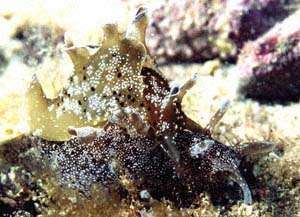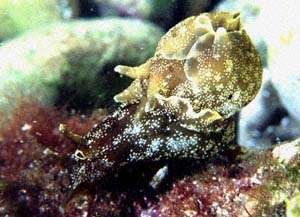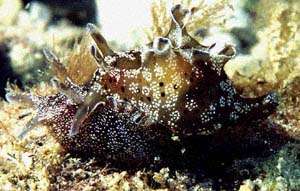Sea Hares - mating chains
June 4, 1998
From: Erwin Koehler

Hello Bill,
I've read (at Steve Long's Opisthobranch Newsletter and at Dr. Peter Wirtz book about Madeira) that Seahares form long chains when mating. I've got 3 photos of Aplysia punctata in the Mediterranean Sea - I thought I got them mating. But in this position it's impossible to build up a chain...
First question: Are they mating?
If not - second question: what else are they doing?
I know, your forum is made for another region and the Med. Sea is far away from Australia...Excuse my GERMENGLISH!
Erwin Koehler
Darmstadt,
Germany
Medslugs.Koehler@t-online.de


I am happy to receive questions from anywhere. My main concern was getting lots of identification questions from parts of the world where others were more qualified to provide answers. General questions such as yours are relevant to all parts of the world. Your Sea Hares appear to be mating to me. The position different opisthobranchs adopt during mating depends on their
anatomy. Even though they all have male and female organs, the position of the penis and the vagina differs in different groups.
In the true nudibranchs both penis and vagina are close together on the right side of the body. This means two animals must be right side to right side for copulation to take place and each animal is then able to insert its penis into its partner at the same time. With Sea Hares however, the penis is on the right side of the head while the vagina opens in the mantle cavity, beneath the shell, deep down between the parapodia.
In Sea Hares it is therefore physically impossible for mating partners to act as both male and female at the same time. In some species, with relatively short "necks" the only way the "male" partner can insert its penis into the "female's" vagina is to climb onto the female as your animals are doing. Related animals like Notarchus and Bursatella also mate like this.
In some species of Aplysia, such as Aplysia sydneyensis and Aplysia extraordinaria, with relatively long "necks", one animal is able to insert its penis into the vagina of the animal in front while still remaining partially on the substrate. In these species chains of mating animals are quite common.
Mating "chains" occur when animals are clustered closely together, either from being washed together during storms or by being artificially housed in buskets or small aquaria. In these situations even "short-necked" species can form chains. Chain-forming is not exclusive to Sea Hares and aglajiid bubble shells such as Chelidonura and Melanochlamys readily form chains when collected in relatively small containers. I have seen three or four aglajiids in a mating chain in the field, and in aquaria I have seen 10-15 together.
So the answer is yes, Sea Hares do sometimes mate in chains, but they also mate in pairs with one acting as a male, the other as a female. Chain mating is different from the reciprocal mating in nudibranchs because in Sea Hares the animal receiving sperm gives its own sperm to a third slug .... Bill Rudman.
Rudman, W.B., 1998 (Jun 4). Comment on Sea Hares - mating chains by Erwin Koehler. [Message in] Sea Slug Forum. Australian Museum, Sydney. Available from http://www.seaslugforum.net/find/140Related messages
-
The Aplysia language of love
From: Scott Cummins, February 16, 2007 -
Re: Sea Hare 'Love Drug'
From: Bill Rudman, August 14, 2006 -
Sea Hare 'Love Drug'
From: Bill Rudman, March 8, 2003 -
Aplysia dactylomela mating chains
From: Anne DuPont, May 27, 2002 -
Asexual reproduction?
From: Wilson, February 2, 2001 -
Aplysia mating chain
From: Bill Rudman, May 9, 2000
